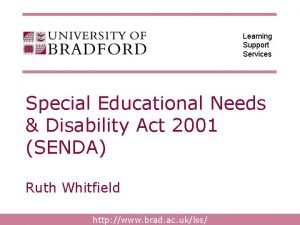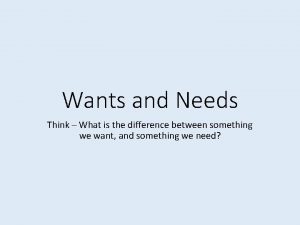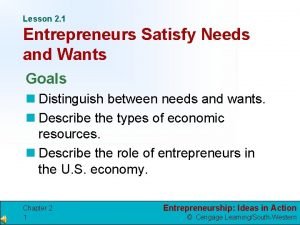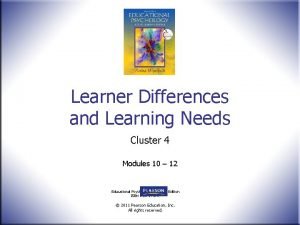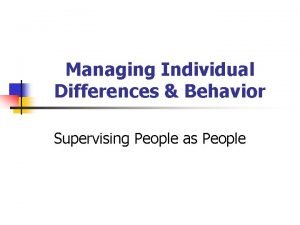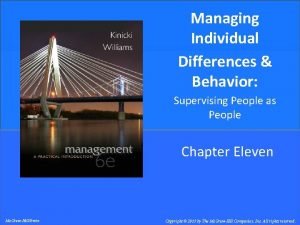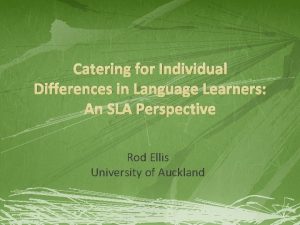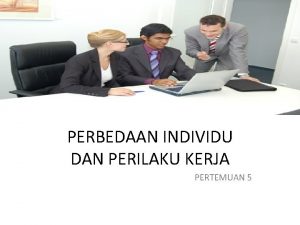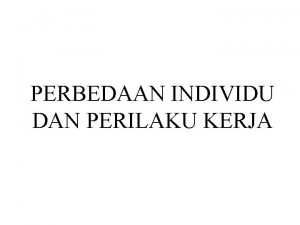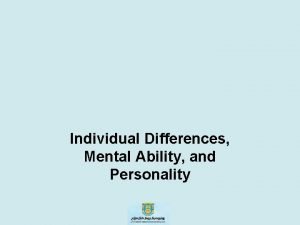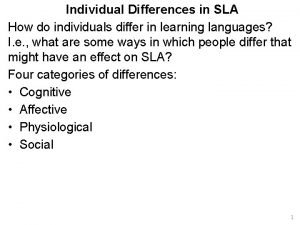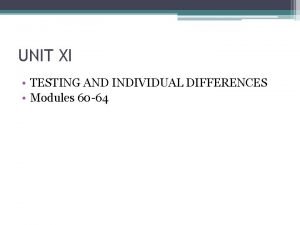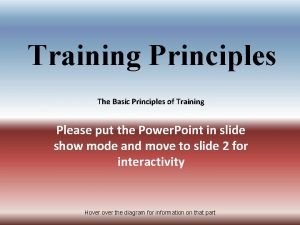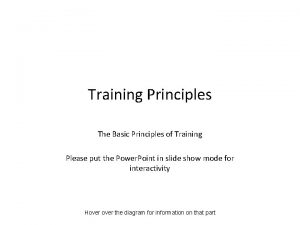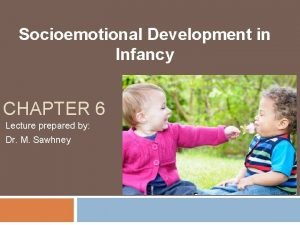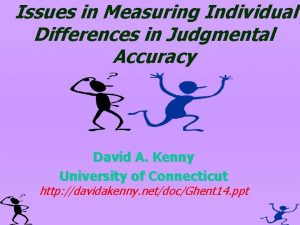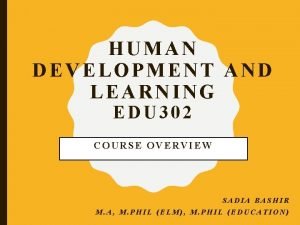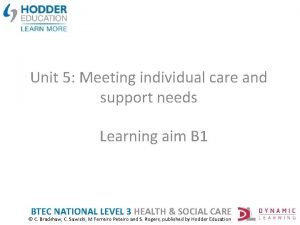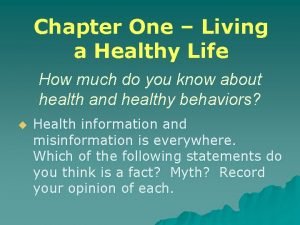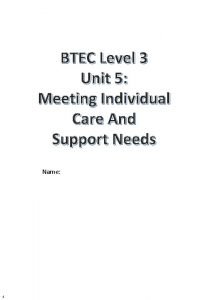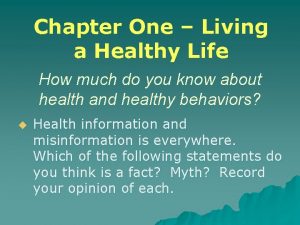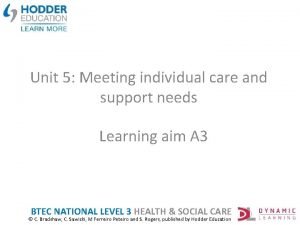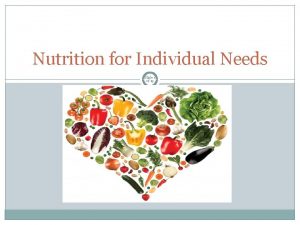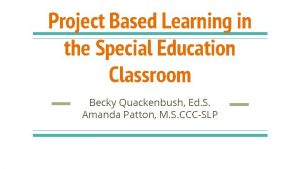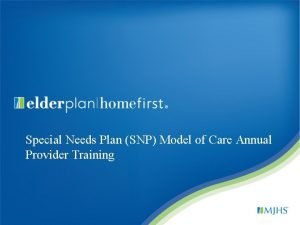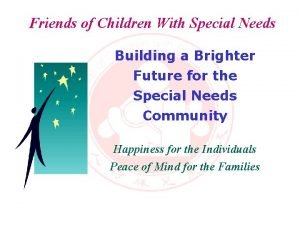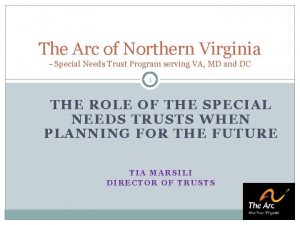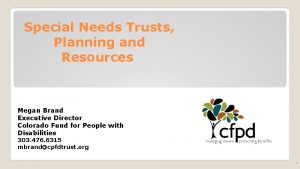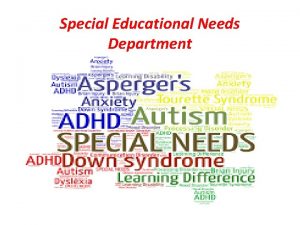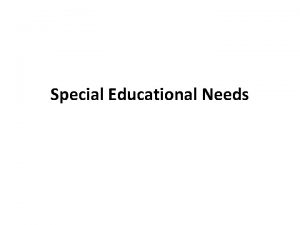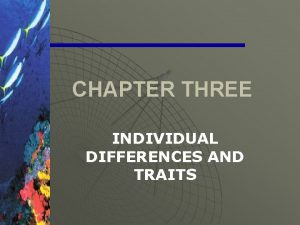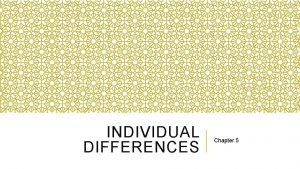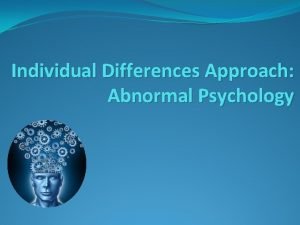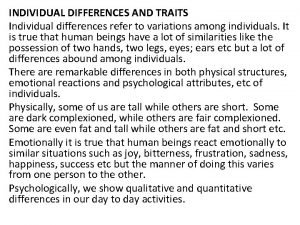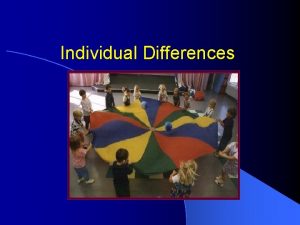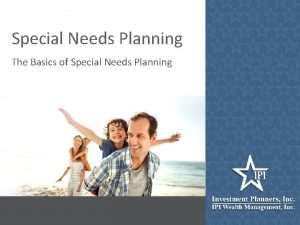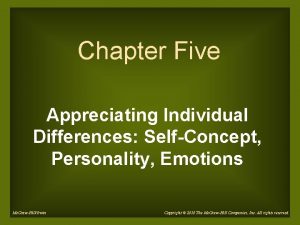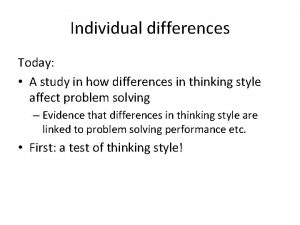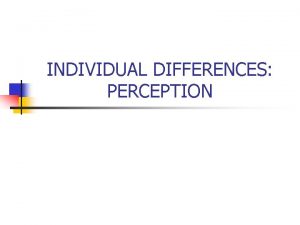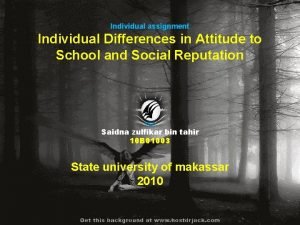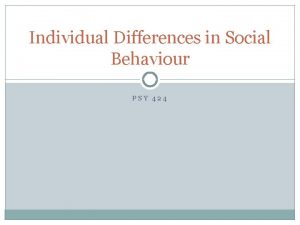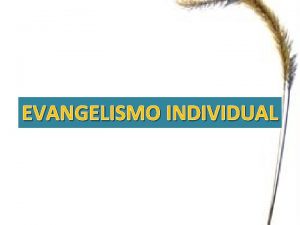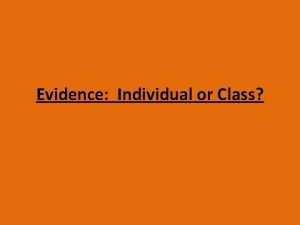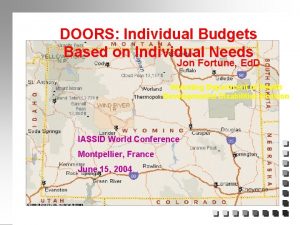Individual Differences Special Educational Needs Chapter Five Educational




































- Slides: 36

Individual Differences & Special Educational Needs Chapter Five Educational Psychology: Developing Learners 6 th edition Jeanne Ellis Ormrod

Individual Differences n Variability in abilities and characteristics among students at a particular age n Students with special needs: Students different enough from their peers to require specially adapted materials and practice Jeanne Ellis Ormrod Educational Psychology: Developing Learners, sixth edition Copyright © 2008 by Pearson Education, Inc. Upper Saddle River, New Jersey 07458 All rights reserved.

Keeping Individual Differences in Perspective n Labels assist teachers in selecting appropriate instructional strategies. n The difficulty of labeling is: n n Labels can be misused and misunderstood. Labels do not define a person. n Differences originate from different sources. n Most differences are the result of both heredity and the environment Jeanne Ellis Ormrod Educational Psychology: Developing Learners, sixth edition Copyright © 2008 by Pearson Education, Inc. Upper Saddle River, New Jersey 07458 All rights reserved.

The Issue of Intelligence n What does it mean to be intelligent? n Is it one ability or many? n Can it be quantified? n How can it be accurately measured if we can’t even properly define it? Jeanne Ellis Ormrod Educational Psychology: Developing Learners, sixth edition Copyright © 2008 by Pearson Education, Inc. Upper Saddle River, New Jersey 07458 All rights reserved.

Intelligence n Ability to modify and adjust behaviors to accomplish tasks successfully n Involves many different mental processes n May vary in nature depending on one’s culture Jeanne Ellis Ormrod Educational Psychology: Developing Learners, sixth edition Copyright © 2008 by Pearson Education, Inc. Upper Saddle River, New Jersey 07458 All rights reserved.

Intelligence… n Is adaptive n Can be related to learning ability n Involves the use of prior knowledge to analyze and understand new situations n Involves many different mental processes n Is evident in different arenas n Is culture specific Jeanne Ellis Ormrod Educational Psychology: Developing Learners, sixth edition Copyright © 2008 by Pearson Education, Inc. Upper Saddle River, New Jersey 07458 All rights reserved.

Limitations of Intelligence Tests n Different kinds of intelligence tests may yield different n n n scores. Students’ performance is affected by many temporary factors, such as general health, mood, fatigue, etc. Test items typically reflect skills valued in mainstream Western culture. Unfamiliarity with the content or types of tasks in particular test items may yield poor performance. Students with limited English proficiency are at a disadvantage. Some students may not be motivated to perform at their best and so may obtain scores that underestimate their abilities. Jeanne Ellis Ormrod Educational Psychology: Developing Learners, sixth edition Copyright © 2008 by Pearson Education, Inc. Upper Saddle River, New Jersey 07458 All rights reserved.

Theories of Intelligence n Spearman’s g (1927) n Theory that ntelligence is a single entity, a general factor that influences one’s ability to learn in a wide variety of contexts n Information-Processing Theorists n Believe that g reflects the speed and efficiency with which people can process information, learning tasks, and problems Jeanne Ellis Ormrod Educational Psychology: Developing Learners, sixth edition Copyright © 2008 by Pearson Education, Inc. Upper Saddle River, New Jersey 07458 All rights reserved.

Theories of Intelligence n Gardner’s Multiple Intelligences n An individual has at least 8 different intelligences that are relatively independent. n Each intelligence may be controlled by different parts of the brain. n Different intelligences may manifest themselves differently in different cultures. n Acceptance of Gardner’s idea is fairly controversial. Jeanne Ellis Ormrod Educational Psychology: Developing Learners, sixth edition Copyright © 2008 by Pearson Education, Inc. Upper Saddle River, New Jersey 07458 All rights reserved.

Gardner’s Multiple Intelligences n Linguistic n Bodily-Kinesthetic n Logical- n Interpersonal Mathematical n Spatial n Musical n Intrapersonal Jeanne Ellis Ormrod Educational Psychology: Developing Learners, sixth edition n Naturalistic Copyright © 2008 by Pearson Education, Inc. Upper Saddle River, New Jersey 07458 All rights reserved.

Sternberg’s Triarchic Theory Jeanne Ellis Ormrod Educational Psychology: Developing Learners, sixth edition Copyright © 2008 by Pearson Education, Inc. Upper Saddle River, New Jersey 07458 All rights reserved.

Distributed Intelligence n Distributed intelligence is the idea that intelligent behavior depends on people’s physical and social support systems. n People can “distribute” their intelligence in three ways: n n n They can use objects, such as technology. They can represent and think about situations they encounter in a symbolic manner, such as in the use of diagrams and charts. They can work with others to explore ideas and solve problems. Jeanne Ellis Ormrod Educational Psychology: Developing Learners, sixth edition Copyright © 2008 by Pearson Education, Inc. Upper Saddle River, New Jersey 07458 All rights reserved.

Measuring Intelligence n Intelligence Tests n General measure of current cognitive functioning, often used in a predictive manner n Provide an IQ score n n Jeanne Ellis Ormrod Educational Psychology: Developing Learners, sixth edition A comparison of a person’s performance with that of others in the same age group Score of 100 indicates average performance Copyright © 2008 by Pearson Education, Inc. Upper Saddle River, New Jersey 07458 All rights reserved.

IQ Score Distribution Jeanne Ellis Ormrod Educational Psychology: Developing Learners, sixth edition Copyright © 2008 by Pearson Education, Inc. Upper Saddle River, New Jersey 07458 All rights reserved.

IQ and Achievement n Performance on intelligence tests is correlated with school achievement. n Important points to remember: Intelligence does not necessarily cause achievement. n The relationship between IQ scores and achievement is not perfect; there always exceptions to the rule. n IQ scores simply reflect a student’s performance on a particular test at a particular time. n Jeanne Ellis Ormrod Educational Psychology: Developing Learners, sixth edition Copyright © 2008 by Pearson Education, Inc. Upper Saddle River, New Jersey 07458 All rights reserved.

Nature, Nurture, & Group Differences in Intelligence has a heritable component. n n Identical twins have more similar IQ scores than fraternal twins. Adopted children are more similar in IQ scores to their biological parents than to their adoptive parents. n Intelligence has an environmental component. n n n E. g. , quality of nutrition in childhood impacts IQ scores. Movement from an impoverished to stimulating environment can provide gains of up to 15 points on intelligence tests. Differences in scores between ethnicities and genders are due largely to differences in experiences. Jeanne Ellis Ormrod Educational Psychology: Developing Learners, sixth edition Copyright © 2008 by Pearson Education, Inc. Upper Saddle River, New Jersey 07458 All rights reserved.

Cognitive Styles and Dispositions n Individual differences in the way that students approach classroom tasks and think about classroom topics n Frequently referred to as learning styles n Several productive dispositions identified by researchers: n n Stimulation seeking Need for cognition Critical thinking Open-mindedness Jeanne Ellis Ormrod Educational Psychology: Developing Learners, sixth edition Copyright © 2008 by Pearson Education, Inc. Upper Saddle River, New Jersey 07458 All rights reserved.

Educating Students with Special Needs in the General Education Classroom n More than two-thirds of American students with special needs are in general ed classrooms for part or all of the day. n Federal legislation mandates inclusion to the greatest extent possible. n Public Law 94 -142: Individuals with Disabilities Education Act (IDEA) n IDEA grants educational rights to people with cognitive, emotional, or physical disabilities from birth to age 21. Jeanne Ellis Ormrod Educational Psychology: Developing Learners, sixth edition Copyright © 2008 by Pearson Education, Inc. Upper Saddle River, New Jersey 07458 All rights reserved.

IDEA n Guarantees the following: n A free and appropriate education n Fair and nondiscriminatory evaluation n Education in the least-restrictive environment n Individualized education program n Due process Jeanne Ellis Ormrod Educational Psychology: Developing Learners, sixth edition Copyright © 2008 by Pearson Education, Inc. Upper Saddle River, New Jersey 07458 All rights reserved.

Students with Cognitive or Academic Difficulties n Learning Disabilities students: n Comprise the largest single category of students with special needs n Have average or above average IQ but specific deficiencies n May have difficulty sustaining attention n Have poor reading skills n Have ineffective learning/memory strategies n Have difficulty with tasks involving abstract reasoning n Have low motivation/poor self-concept n Have poor motor skills (not always) n Have poor social skills (not always) Jeanne Ellis Ormrod Educational Psychology: Developing Learners, sixth edition Copyright © 2008 by Pearson Education, Inc. Upper Saddle River, New Jersey 07458 All rights reserved.

Students with Cognitive or Academic Difficulties n Strategies for adapting instruction for students with learning disabilities include: Minimizing potentially distracting stimuli n Using multiple methods of presentation n Analyzing students’ errors for clues about processing difficulties n Teaching learning and memory strategies n Providing study aids n Jeanne Ellis Ormrod Educational Psychology: Developing Learners, sixth edition Copyright © 2008 by Pearson Education, Inc. Upper Saddle River, New Jersey 07458 All rights reserved.

Students with Cognitive or Academic Difficulties n Attention-Deficit Hyperactivity Disorder (ADHD) n Children with ADHD have the following characteristics: n n n Jeanne Ellis Ormrod Educational Psychology: Developing Learners, sixth edition Inattentiveness, hyperactivity, and impulsive behavior Cognitive processing difficulties Poor school achievement Exceptional imagination and creativity Difficulty interpreting and reasoning about social situations Few friendships Copyright © 2008 by Pearson Education, Inc. Upper Saddle River, New Jersey 07458 All rights reserved.

Students with Cognitive or Academic Difficulties n Strategies for adapting instruction for students with ADHD include: Giving the most challenging academic subjects and tasks in the morning n Teaching attention-maintaining strategies n Providing outlets for excessive energy n Helping them establish routines n Teaching and encouraging appropriate classroom behaviors n Jeanne Ellis Ormrod Educational Psychology: Developing Learners, sixth edition Copyright © 2008 by Pearson Education, Inc. Upper Saddle River, New Jersey 07458 All rights reserved.

Students with Cognitive or Academic Difficulties n Speech and communication disorders are characterized by impairments in spoken language and/or comprehension that interfere with classroom performance. n Students with speech and communication disorders have the following characteristics: Difficulty with speaking, particularly in public n Poor reading/writing skills n Jeanne Ellis Ormrod Educational Psychology: Developing Learners, sixth edition Copyright © 2008 by Pearson Education, Inc. Upper Saddle River, New Jersey 07458 All rights reserved.

Students with Cognitive or Academic Difficulties n Strategies for adapting instruction for students with speech and communication disorders include: n n Encouraging regular oral communication Asking for clarification when a message is unclear Providing a supportive environment for public speaking Listening patiently so that students have adequate time to express themselves Jeanne Ellis Ormrod Educational Psychology: Developing Learners, sixth edition Copyright © 2008 by Pearson Education, Inc. Upper Saddle River, New Jersey 07458 All rights reserved.

Students with Social or Behavioral Problems n Behaviors that consistently and significantly disrupt academic learning and performance n n n Difficulty interacting in socially acceptable ways Difficulty maintaining satisfactory interpersonal relationships Low self-esteem Frequent absences Inability to recognize the severity of problem Jeanne Ellis Ormrod Educational Psychology: Developing Learners, sixth edition Copyright © 2008 by Pearson Education, Inc. Upper Saddle River, New Jersey 07458 All rights reserved.

Students with Social or Behavioral Problems n Strategies for adapting instruction for students with social or behavioral problems include: n n n n Being alert for problems at home (e. g. , abuse) Making classroom events/topics relevant Showing a personal interest in student Being alert for suicidal signs TEACHING interpersonal skills Being clear about expectations Identifying problems early Jeanne Ellis Ormrod Educational Psychology: Developing Learners, sixth edition Copyright © 2008 by Pearson Education, Inc. Upper Saddle River, New Jersey 07458 All rights reserved.

Autism Spectrum Disorders n Autism is a disability characterized by impaired social interaction and communication, repetitive behaviors, restricted interests, and a strong need for a predictable environment. n Students with autism often have: n n n Strong visual-spatial thinking skills Impaired social cognition Echolalia Strong attachments to certain inanimate objects Abnormal movements Jeanne Ellis Ormrod Educational Psychology: Developing Learners, sixth edition Copyright © 2008 by Pearson Education, Inc. Upper Saddle River, New Jersey 07458 All rights reserved.

Mental Retardation n Disability characterized by significantly below- average general intelligence and deficits in adaptive behavior n Different than Learning Disabled—belowaverage IQ (70 or below) n Require adapted instruction n Often provided with vocational skills Jeanne Ellis Ormrod Educational Psychology: Developing Learners, sixth edition Copyright © 2008 by Pearson Education, Inc. Upper Saddle River, New Jersey 07458 All rights reserved.

Students with Physical/Sensory challenges n Includes illnesses or physical impairments such as deafness, blindness, etc. n Learning ability usually perfectly normal n Often given fewer opportunities to interact with peers n Possibly low self-esteem, insecurity, embarrassment, etc. Jeanne Ellis Ormrod Educational Psychology: Developing Learners, sixth edition Copyright © 2008 by Pearson Education, Inc. Upper Saddle River, New Jersey 07458 All rights reserved.

Students with Physical/Sensory Challenges n Adapting instruction for students with physical and/or sensory challenges: Be sensitive n Learn about physical condition of student n Educate classmates about condition n Refer to text for specific recommendations for each type of deficit n Jeanne Ellis Ormrod Educational Psychology: Developing Learners, sixth edition Copyright © 2008 by Pearson Education, Inc. Upper Saddle River, New Jersey 07458 All rights reserved.

Giftedness n There seems to be no universal agreement on what constitutes a gifted child. Creativity and imaginative thinking are characteristics. n Some “gifted” children excel in many areas, some in specific areas. n IQ of 130 or higher can be used as an identifier. n Jeanne Ellis Ormrod Educational Psychology: Developing Learners, sixth edition Copyright © 2008 by Pearson Education, Inc. Upper Saddle River, New Jersey 07458 All rights reserved.

Giftedness n Common characteristics of the gifted child include: Learn with little effort n Highly motivated n n Terman’s longitudinal study found gifted children to be “well-rounded, ” emotionally stable, with good health, lower rates of delinquency, etc. Jeanne Ellis Ormrod Educational Psychology: Developing Learners, sixth edition Copyright © 2008 by Pearson Education, Inc. Upper Saddle River, New Jersey 07458 All rights reserved.

Giftedness: The Problems n Students may feel impatient with peers who are not as smart as they. n Gifted students report frequent boredom and frustration at school. n Adjustment problems are evident in the extremely gifted. Jeanne Ellis Ormrod Educational Psychology: Developing Learners, sixth edition Copyright © 2008 by Pearson Education, Inc. Upper Saddle River, New Jersey 07458 All rights reserved.

Giftedness n Adapting instruction for the gifted student includes: n Providing individualized tests and assignments n Forming study groups of students with similar interests and abilities n Teaching complex cognitive skills within the context of specific subject areas n Providing opportunities for independent study n Encouraging students to set high goals n Seeking outside resources Jeanne Ellis Ormrod Educational Psychology: Developing Learners, sixth edition Copyright © 2008 by Pearson Education, Inc. Upper Saddle River, New Jersey 07458 All rights reserved.

Individual Differences: The Big Picture n General strategies for accommodating students’ differing abilities and disabilities within the general classroom include: n n n n n Obtaining as much information as possible about each student Individualizing instruction for nondisabled students as well as for those with disabilities Being flexible in approaches to instruction Holding the same expectations for students with disabilities as for other students Identifying and teaching important prerequisite skills Consulting and collaborating with specialists Including students in planning and decision making Promoting interaction between all students Being alert to identify students who may qualify for special services Jeanne Ellis Ormrod Educational Psychology: Developing Learners, sixth edition Copyright © 2008 by Pearson Education, Inc. Upper Saddle River, New Jersey 07458 All rights reserved.
 Special educational needs and disability act 2001
Special educational needs and disability act 2001 Needs and wants examples
Needs and wants examples 10 differences between needs and wants
10 differences between needs and wants Learner differences and learning needs
Learner differences and learning needs Managing individual differences and behavior
Managing individual differences and behavior Managing individual differences and behavior
Managing individual differences and behavior Field dependent vs field independent
Field dependent vs field independent Individual differences factors
Individual differences factors Hukum perbedaan individu
Hukum perbedaan individu Perbedaan individu dan perilaku kerja
Perbedaan individu dan perilaku kerja What are type a people
What are type a people Individual differences in sla
Individual differences in sla Unit xi testing and individual differences
Unit xi testing and individual differences Basic principles of training
Basic principles of training Principles of training individual differences
Principles of training individual differences Involves individual differences in behavioral styles
Involves individual differences in behavioral styles Conclusion of individual differences
Conclusion of individual differences Growth and development
Growth and development Primary needs and secondary needs
Primary needs and secondary needs Primary needs and secondary needs
Primary needs and secondary needs Alpha press murray
Alpha press murray Strategic gender needs and practical gender needs
Strategic gender needs and practical gender needs What is target needs
What is target needs Unit 5: meeting individual care and support needs
Unit 5: meeting individual care and support needs Individual needs examples
Individual needs examples A health-literate individual needs to be
A health-literate individual needs to be Unit 5 meeting individual care and support needs coursework
Unit 5 meeting individual care and support needs coursework 4 attributes that a health-literate individual needs
4 attributes that a health-literate individual needs Unit 5 meeting individual care and support needs assignment
Unit 5 meeting individual care and support needs assignment Individual needs analysis
Individual needs analysis Nutrition for individual needs
Nutrition for individual needs Project based learning for students with special needs
Project based learning for students with special needs Elderplan plan materials
Elderplan plan materials Teachwise app
Teachwise app Friends of children with special needs
Friends of children with special needs Special needs trust virginia
Special needs trust virginia Special needs trusts colorado
Special needs trusts colorado
